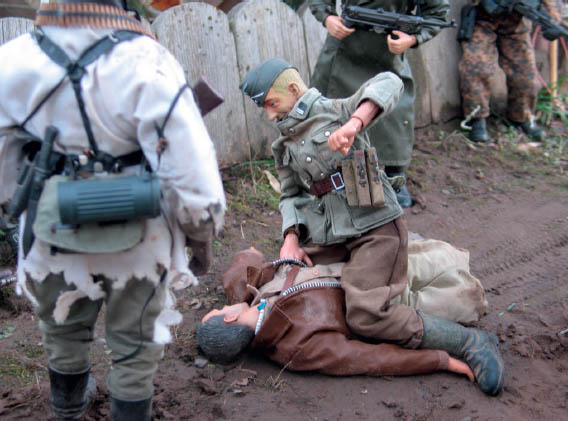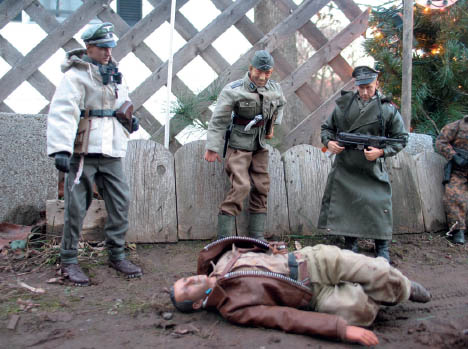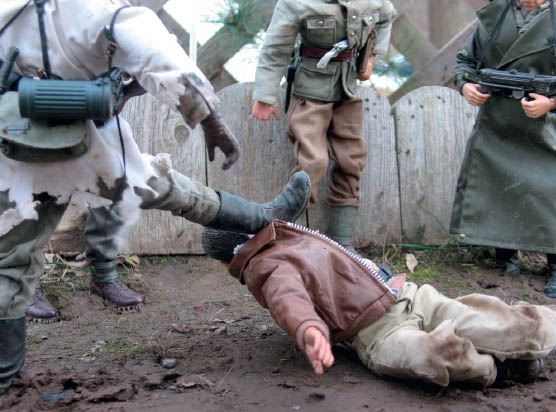A soldier is killed during a New Year’s patrol of Marwencol.
A police photo from the scene of Mark’s attack on April 8, 2000. (photo provided by the Ulster County Sheriff’s Office)
On Friday, April 7, 2000, Mark was working his shift at the Anchorage. Owner Julie Swarthout, bartender Tom Neubauer, and some friends were making plans to check out the karaoke night at a local bar called the Luny Tune Saloon after work. Like always, they invited Mark along. And like always, he declined. Mark preferred to drink alone.
Several hours later, Julie and the others stepped into the darkness of the Luny Tune and felt immediately uneasy. The patrons seemed rude and there was something off about the atmosphere, so they left to find another bar.
Meanwhile, after a few drinks at home, Mark finally worked up the courage to join his friends. He pulled on a Harley-Davidson shirt, his white sailor cap, and a black leather jacket with an American flag on the back and made his way down to the bar, arriving at around 10:00 p.m. He’d just missed his friends.
Mark didn’t have a cell phone to call them, so he sat down at the bar and ordered his signature drink, a boilermaker—“a shot of whiskey and a hug of beer.” He emptied one after the other for the next four hours.
Saturday, April 8, 2000
At around 1:30 a.m., Mark got into a conversation with a lanky twenty-three-year-old blond guy named Freddy Hommel, who was sitting at the bar. The conversation got off to a spirited start. Both Hommel and Mark were of German ancestry, so they talked about their heritage and tossed around a few German words. The bartender heard Hommel joke about “Nazism, Hitler, [he] said something about swastikas, just generally joking around and laughing.” Then the mood changed.
A few people overheard Mark reveal to Hommel that he was a cross-dresser. The conversation grew awkward; Hommel looked upset.
Across the room, Hommel’s friend Richard Purcell, twenty-one years old, was standing with a group of friends by an arcade game. He recognized the look on Hommel’s face; he’d seen it before—usually before a fight. His friends “Black Freddy,” sixteen years old, David Mead, nineteen years old, and Noah Rand, also twenty-one years old, spotted it too. Black Freddy walked over to Hommel twice to tell him to calm down.
The conversation continued for a few minutes until Hommel stood up and ordered another drink. The bartender refused—closing time—so Hommel grabbed his friends and walked out to smoke by the side of the building. Mark walked out after them but returned a few seconds later to grab his jacket, which he’d left on a chair. He was visibly drunk (medical records later listed his blood alcohol level at over 0.30), so the bartender asked if he needed a ride. Mark said no thanks, he’d walk home.
It was about 2:10 in the morning. Mark walked outside and talked for a minute with Hommel and his friends as they smoked. Purcell later claimed that Hommel was taunting Mark, trying to get him to say something offensive, something about hating black people, like Black Freddy. But Mark didn’t take the bait.
“Hey man,” he said, “I don’t hate anybody. Everyone’s cool.”
A minute or two later, the bartender glanced through the glass panels of the front door and saw Mark walk toward the street. Trailing behind him was Hommel. Hommel let Mark walk a few yards down the street and then, when Mark wasn’t looking, he charged.
Hommel ran at Mark and rammed into him with his shoulder, tackling him to the ground. The guys heard an audible thump when Mark’s head hit the pavement, and he was out cold. Then Hommel started swinging.
This was Hommel’s fight. None of his friends had a problem with Mark, but there’s an unwritten code among guys like Purcell and Hommel: if your friend gets into a fight, you have his back. So the four ran over and jumped in.
Later on, each of them would tell authorities that they kicked less than everyone else and were more concerned about Mark than the others. The only thing they agreed on was that Mead and Rand didn’t jump in with quite the same enthusiasm as Hommel, Purcell, and Black Freddy.
While Mead and Rand kicked at Mark’s legs, Black Freddy later told detectives that he, Hommel, and Purcell stomped repeatedly on Mark’s head and chest with their boots.
Purcell claimed that Black Freddy punted the right side of Mark’s face like a football two or three times, knocking it back and forth. Then he and Hommel joined in, ultimately smashing in Mark’s right eye.
The whole fight only lasted a minute or so, but Mark’s face had been destroyed and he wasn’t fighting back. That scared Mead and Rand. They dragged the others into their two cars and sped off, leaving Mark unconscious and bleeding in the middle of the road. At about the same time, a local bartender named Nora Noonan was just ending her shift at nearby Riccardi’s Hideaway. She picked up her daughter at a friend’s house and headed home. It was a little after 2:30 a.m., about twenty minutes after the attack. As they turned onto Lincoln Street, they saw what looked like a black garbage bag in the middle of the street. No...it was a man.
Noonan drove around Mark to a nearby diner to look for a pay phone but couldn’t find one. So she pulled out and parked in front of Mark to protect him from traffic.
Noonan and her daughter ran over and shook Mark, but he didn’t respond. He looked terrible—his eyes were swollen shut, his breathing was ragged, and he had what looked like a tire track across his forehead. Noonan assumed he’d been run over, not knowing that the tire track was actually a boot print.
Noonan raced over to the Luny Tune and banged on the door. Finally, the bartender and the owner answered. Noonan told them about the guy in the street, and the bar’s owner muttered, “Those darn kids.”
The group ran back to Mark, and Noonan noticed he wasn’t breathing anymore. So they rolled him over onto his side and blood came spilling out of his nose and mouth. If that blood had blocked his breathing for even a minute or two longer, Mark would have died.
The bar’s owner called 911, and paramedics sped Mark over to the ER at Kingston Hospital. He was in respiratory failure. With only minutes to spare, Dr. Joel Ginsberg and his team vacuumed the blood from Mark’s throat, intubated him, and put him on a ventilator to get him breathing again.
A CT scan of Mark’s head showed that Mark’s five attackers had completely destroyed the bony cavity that supported his right eye. It would need to be reconstructed, or Mark’s eye would sink into his sinus cavities, leaving him disfigured and potentially blind in that eye.
That level of surgery was well beyond the capabilities of Kingston’s ER, so Dr. Ginsberg had Mark transferred to Westchester Medical Center, in Valhalla, New York.
It was now late morning on Saturday, April 8. While Mark was being moved to Westchester Medical, Purcell was heading home, having just walked his pregnant girlfriend to work. Along the way, he spotted a friend of his named Steve and flagged him down. Steve had been at the Luny Tune the night before but had left with a girl before the fight began.
Purcell told Steve about how he and his friends had “stomped [Mark] and just kept stomping him, on his head.” As proof, Purcell showed Steve the dried blood on his boots. Then he asked if Steve wanted to hang out at a party that night. Steve said Purcell seemed normal, “like happy Richie...how he always acted.”



Photos illustrating a Marwencol story in which Mark’s alter ego, Hogie, is nearly beaten to death by five SS soldiers.
Mug shots of Freddy Hommel (left) and Richard Purcell soon after the attack. (photos provided by the Ulster County Sheriff’s Office)
Over at Westchester Medical, Mark’s family was finally admitted to his room in intensive care after hours of waiting. His mother was horrified by what she saw. “There was really no way I could have recognized Mark,” she recalled. “I knew his hands and feet, but his face was just a swollen, purple mess.”
In preparation for surgery on his eye, Mark was placed in a medically induced coma. At first, his body reacted badly; he jerked involuntarily and his vitals were unsteady. Doctors were stumped until Mark’s friend Tom told them that Mark was an alcoholic. After just a day in intensive care without alcohol, his body was going through withdrawal.
Sunday, April 9, 2000
While doctors stabilized Mark, Ulster County detectives began to round up the suspects.
Rand and Mead each claimed to have not taken part in the beating. Purcell and Black Freddy confessed to some violence, but both placed the blame squarely on Hommel, who had become upset after Mark revealed that he was a cross-dresser.
Hommel initially joked around with detectives, calling himself a karaoke superstar. Then he defended his actions by claiming Mark was a “cross-dressing murderer”—a neo-Nazi who thought POWs deserved to die. He told detectives that Mark had threatened to kick his ass; he thought Mark was grabbing for a knife, so he tackled him. And the fight was over so quickly, they couldn’t have done that much damage.
A police photo of Mark in the hospital after the attack. (photo provided by the Ulster County Sheriff’s Office)
Thursday, April 13, 2000
Four days later, doctors finally operated on Mark’s eye. His face was “peeled back and...the bone fragments were removed. The eye floor was rebuilt with a prosthesis.”
The prosthesis was essentially a plastic cup, inserted behind his eyeball to keep it from sinking into his head. To this day, Mark can feel the cup’s seam under his skin. Aside from the feeling of the prosthesis, all other physical traces of the attack were erased by Mark’s plastic surgeon.
Monday, April 17, 2000
After nine days in a coma, Mark finally came around. Now the real evaluation would begin. Doctors had seen some volume loss in Mark’s brain, but the extent of brain damage could only really be assessed by comparing a person’s current abilities to their abilities before the trauma.
It wasn’t good.
At first, Mark couldn’t speak at all. After a few days, he began to form words, but it was clear he had amnesia. He thought it was 1984 and that he was in a naval hospital.
“I remember opening up my eyes and seeing that asbestos ceiling design, and I didn’t know where I was,” Mark recalled. “I thought that I was in a naval hospital in Spain. I mean, that’s how far back these guys knocked me.”
Mark found he could remember his immediate family but no one else from his recent past—not even his young niece or nephew. He’d lost most of his adult memories—his alcoholic past, his former marriage, friendships. And he’d forgotten how to do simple everyday things, like tying his shoes, going to the bathroom, or eating with a fork.
The damage to Mark’s brain caused other issues as well. He had to learn how to walk again. His depth perception was off. And his right hand—his drawing hand—shook badly.
While Mark took his literal first steps toward recovery, his friend and Anchorage coworker, Tom, began to prepare for Mark’s eventual release from the hospital. Before the attack, Mark and Tom had made arrangements to move in together to save on expenses. Now Tom found himself in the unanticipated position of being Mark’s principal caregiver and closest friend.
Tom worked for weeks to get permission from the housing authority to enter and clean Mark’s apartment, where open containers of food had spoiled. “They only let me in there like a day before he came home from the hospital. I wasn’t aware of the amount that he drank. I found about fifty half-gallon liquor bottles in his apartment—under the bed, in the closets, piles of them. I cleaned all of that out.”
After forty-three days in the hospital, Mark’s Medicaid ran out. He was discharged and sent home with Tom, who took him back to an apartment and a life he didn’t remember.